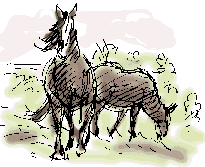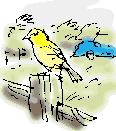Blossom and Beauty
 Two Clydesdales in a meadow on near the canal developed severe rashes on their white face-flashes during a spell of sunny weather a month or so ago. The vet prescribed a cream for the rash and took a blood test that determined liver damage. What had caused the symptoms? Well, Blossom, as you can see by her shape, will eat anything. A short stroll around the field revealed three possible culprits;
Two Clydesdales in a meadow on near the canal developed severe rashes on their white face-flashes during a spell of sunny weather a month or so ago. The vet prescribed a cream for the rash and took a blood test that determined liver damage. What had caused the symptoms? Well, Blossom, as you can see by her shape, will eat anything. A short stroll around the field revealed three possible culprits;  Meadow Buttercup, which is so widespread it is unlikely to be the cause,
Meadow Buttercup, which is so widespread it is unlikely to be the cause,  Common Ragwort, more of a possibility with it's cocktail of alkaloids, but horses normally avoid it when green because of it's bitter taste, and finally, and, I think, most likely, Hogweed. I remember this giving me a really nasty rash a few years ago after I'd cleared it with my bare hands on a sunny day. It is what I believe is called photo-toxic, it's worst effects are felt when the affected skin is exposed to sunlight. The sap can spray you as you clear it, so use a strimmer with caution. It is also proverbial that children use the hollow stems as pea-shooters, which is definitely not recommended.
Common Ragwort, more of a possibility with it's cocktail of alkaloids, but horses normally avoid it when green because of it's bitter taste, and finally, and, I think, most likely, Hogweed. I remember this giving me a really nasty rash a few years ago after I'd cleared it with my bare hands on a sunny day. It is what I believe is called photo-toxic, it's worst effects are felt when the affected skin is exposed to sunlight. The sap can spray you as you clear it, so use a strimmer with caution. It is also proverbial that children use the hollow stems as pea-shooters, which is definitely not recommended.
 On a dull day a Yellowhammer provides a complementary contrast to a haystack shrouded in blue plastic.
On a dull day a Yellowhammer provides a complementary contrast to a haystack shrouded in blue plastic.
We recognise the Goldcrests at the edge of the wood by their calls, which we reckon is not as high-pitched as those of Long-tailed tits. But I should mention that the bird book seems to suggest the Goldcrest would be the higher-pitched.
Richard Bell's Nature Diary, Wednesday, 21st October 1998
Next day
Previous day
Nature Diary
Wild West Yorkshire
 Two Clydesdales in a meadow on near the canal developed severe rashes on their white face-flashes during a spell of sunny weather a month or so ago. The vet prescribed a cream for the rash and took a blood test that determined liver damage. What had caused the symptoms? Well, Blossom, as you can see by her shape, will eat anything. A short stroll around the field revealed three possible culprits;
Two Clydesdales in a meadow on near the canal developed severe rashes on their white face-flashes during a spell of sunny weather a month or so ago. The vet prescribed a cream for the rash and took a blood test that determined liver damage. What had caused the symptoms? Well, Blossom, as you can see by her shape, will eat anything. A short stroll around the field revealed three possible culprits; 
 On a dull day a Yellowhammer provides a complementary contrast to a haystack shrouded in blue plastic.
On a dull day a Yellowhammer provides a complementary contrast to a haystack shrouded in blue plastic.